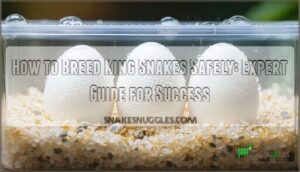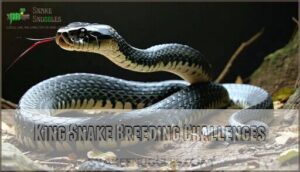This site is supported by our readers. We may earn a commission, at no cost to you, if you purchase through links.

You’ll need separate enclosures for males and females, as these snakes can turn cannibalistic faster than you’d expect.
Start brumation in December by gradually cooling temperatures to 50-55°F for 8-12 weeks.
After warming them back up in spring, introduce pairs for brief supervised meetings—never leave them unattended.
Females typically lay 3-15 eggs after a 60-day gestation period.
Maintain incubation temperatures at 78-82°F with 90% humidity for roughly 60 days.
The key is patience and vigilance throughout each stage, since one misstep can derail months of careful planning and preparation.
Table Of Contents
- Key Takeaways
- King Snake Breeding Basics
- Breeding King Snakes Safely
- King Snake Reproduction Cycle
- King Snake Breeding Challenges
- Successful King Snake Breeding Tips
- Frequently Asked Questions (FAQs)
- What time of year do king snakes mate?
- How to breed snakes in captivity?
- How long does it take for king snake eggs to hatch?
- Can king snakes breed with other snake species?
- How many eggs do king snakes typically lay?
- What age should king snakes start breeding?
- Do king snakes require veterinary checkups before breeding?
- How long between successful breeding attempts?
- Conclusion
Key Takeaways
- Start brumation in December – Cool your snakes to 50-55°F for 8-12 weeks to trigger their natural reproductive instincts and improve fertility rates.
- Never leave breeding pairs unsupervised – King snakes can turn cannibalistic quickly, so you’ll need to monitor every mating introduction closely and separate them immediately after copulation.
- Wait for proper weight and maturity – Don’t attempt breeding until your snakes reach 100-300g (depending on species) and 2-3 years of age for safe reproduction.
- Maintain precise incubation conditions – Keep eggs at 78-82°F with 90% humidity for 55-75 days, using vermiculite substrate to ensure healthy hatchlings.
King Snake Breeding Basics
Successfully breeding king snakes requires careful attention to their weight, age, and seasonal cycles before you even consider pairing them.
You’ll need to establish proper housing conditions and implement a controlled brumation period to trigger their natural reproductive instincts.
King Snake Mating Season
Your king snake’s breeding season kicks off in spring, typically March through June, when rising temperatures trigger their natural courtship rituals.
Males actively hunt for females using pheromone trails, displaying distinct mating behaviors like tail vibrations and neck-biting during prime timing.
Watch for fertility signs as seasonal changes awaken their reproductive instincts after winter brumation.
These snakes thrive across North and Central America, with their natural habits and habitats being a key part of their reproductive instincts.
Pre-Breeding Preparation
Proper preparation sets the foundation for successful king snake breeding. You’ll need to achieve ideal weight requirements—adults should weigh 100-300g depending on species before breeding attempts.
Plan for a brumation length of 2-3 months at 55-65°F to improve fertility rates. Implement separate housing for males to prevent combat and accidental cannibalism.
Begin feeding cessation 2-3 weeks before cooling to avoid digestive complications. After the cooling period, offer only small rewarming meals as your snakes adjust to normal temperatures.
Housing and Feeding Requirements
Success in king snake breeding hinges on proper housing setup and consistent feeding schedules.
Adult breeding pairs require individual enclosures measuring 40+ gallons with secure lids to prevent escapes.
Maintain basking temperatures around 85-88°F with a cool side at 75-80°F using under-tank heaters.
Feed appropriately-sized prey every 7-10 days, ensuring prey width matches the snake’s thickest body section.
A varied diet can provide enhanced nutrient diversity.
Provide fresh water access weekly, using shallow dishes that won’t tip over during exploration.
Breeding King Snakes Safely
Safety remains your top priority when breeding king snakes. You’re dealing with powerful constrictors that can seriously injure each other or you if proper precautions aren’t followed. Always handle snakes with confidence and respect – they sense hesitation and may react defensively.
Critical Safety Measures:
- Never leave breeding pairs unsupervised – Males can kill females through aggressive mating behavior or accidental constriction
- Use feeding tongs and hooks – Direct hand contact during breeding season increases bite risk substantially
- Maintain separate secure enclosures – Prevents combat, cannibalism, and unwanted hybridization between different morphs
Genetic diversity should guide your morph selection process. Avoid pairing closely related snakes, which can cause long-term health problems in offspring. Ethical considerations matter too – responsible breeders don’t contribute to oversaturated markets.
Your king snake care routine must account for heightened aggression during breeding season. This snake breeding guide emphasizes that breeding snakes safely requires constant vigilance and proper equipment. To guarantee safety, remember to research local venomous snake laws before beginning any breeding program.
King Snake Reproduction Cycle
Understanding the king snake reproduction cycle helps you time breeding activities and prepare for each critical phase.
You’ll need to coordinate brumation, mating, egg-laying, and incubation periods to maximize breeding success and guarantee healthy offspring.
Brumation Period Requirements
Successfully breeding king snakes requires careful attention to brumation length and temperature ranges.
Cool your snakes at 45-55°F for 3-4 months, maintaining water availability throughout.
Stop feeding during the 2-4 weeks before brumation begins.
Keep humidity levels at 40-60% in complete darkness.
This critical period synchronizes breeding cycles for king snake care success.
A secure vivarium is essential for their well-being, ensuring hazard-free enclosure.
Mating and Egg-Laying Process
After completing brumation, your king snakes will begin their courtship rituals when temperatures warm. Males actively pursue females through scent tracking and physical contact.
King Snake Mating Process:
- Courtship rituals involve chin rubbing and body alignment lasting several hours
- Copulation duration typically ranges from 30 minutes to 4 hours
- Females lay eggs 30-60 days after successful mating
- Clutch size averages 5-17 eggs depending on female size
- Post-laying care requires immediate female separation and feeding
Egg deposition occurs in secluded areas where females create shallow nests. Monitor your breeding pairs closely during oviposition to guarantee successful snake egg incubation setup.
Incubation and Hatching Conditions
Proper incubation transforms your king snake eggs into healthy hatchlings through precise environmental control.
You’ll need to maintain consistent temperature and humidity throughout the incubation period.
| Parameter | Ideal Range | Monitoring Frequency | Notes |
|---|---|---|---|
| Temperature Control | 78-82°F (25-28°C) | Daily checks | Use reliable thermostat |
| Humidity Levels | 85-95% | Every 2-3 days | Prevent mold formation |
| Substrate Choice | Vermiculite/perlite mix | Initial setup | 1:1 ratio by weight |
| Incubation Time | 55-75 days | Weekly candling | Temperature dependent |
To guarantee proper conditions, consider using a specialized reptile incubator.
Your snake egg incubation success depends on stable conditions and proper substrate choice for hatching king snakes effectively.
King Snake Breeding Challenges
You’ll face several critical challenges when breeding king snakes that can make or break your success.
Breeding success hangs on precise preparation, careful monitoring, and respect for these powerful predators.
Combat between males, cannibalistic behavior, and maintaining proper environmental conditions require careful attention to prevent serious problems, including combat between males and ensuring proper conditions to prevent cannibalistic behavior.
Common Health Issues
Why do health problems plague breeding king snakes?
Breeding stress weakens immune systems, making snakes vulnerable to respiratory issues, scale rot, and parasites.
Egg binding threatens female king snake health during reproduction.
Poor husbandry conditions compound these risks, leading to mouth rot and skin infections.
Regular veterinary care and disease prevention measures protect your breeding stock from these common ailments, including egg binding and poor husbandry.
Combat and Cannibalism Prevention
King snakes are notorious for their cannibalistic nature, making combat prevention essential for successful breeding.
Never underestimate their predatory instincts—even breeding pairs can turn deadly without warning.
Never underestimate their predatory instincts—even breeding pairs can turn deadly.
- Separate Housing: Keep each snake in individual enclosures year-round except during supervised mating
- Supervise Pairing: Monitor every breeding introduction closely; separate immediately at aggressive signs
- Size Discrepancies: Match similarly-sized breeding pairs to prevent larger snakes attacking smaller mates
Watch for stress reduction indicators and unusual feeding response behaviors during introductions.
Creating a suitable environment may require a specialized breeding enclosure.
Environmental and Dietary Factors
Temperature gradients between 75-85°F and consistent humidity levels around 50-60% create ideal breeding conditions.
Your enclosure size should accommodate natural behaviors, while proper prey size matches your snake’s girth.
Don’t overlook supplementation needs during breeding season.
Maintain steady feeding schedules with appropriately-sized prey items, and guarantee constant hydration through clean water sources to support consistent humidity levels.
Successful King Snake Breeding Tips
You’ll dramatically improve your breeding success by focusing on proper weight requirements, strategic pairing, and careful post-breeding monitoring.
These proven techniques help guarantee healthy offspring while minimizing risks to your adult snakes throughout the entire reproductive process, ensuring a successful outcome with healthy offspring.
Weight and Size Requirements
Adult king snakes need minimum weight of 100-300g depending on species before reptile breeding begins.
Some king snake morphs breed safely at 100g while larger species require 300g+.
Body condition matters more than age – you’ll want plump, healthy snakes with ideal size reflecting their genetics.
Growth stages vary substantially between subspecies, so research your specific king snake genetics before attempting snake breeding for successful reptile care outcomes.
It’s also important to provide secure hides for stress reduction.
This will help ensure the snakes are comfortable and secure, which is crucial for successful reptile care and reptile breeding.
Sex Ratio and Pairing Strategies
For ideal king snake breeding success, establishing proper sex ratios and pairing strategies prevents male combat while maximizing genetic diversity.
Here’s your breeding blueprint:
- Maintain 1:3 male-to-female ratios for ideal breeding efficiency
- Rotate males every 3-4 days between females to prevent breeding fatigue
- Document all pairings in breeding records to track success rates
- Introduce males to females’ enclosures to reduce territorial stress during courtship
- Monitor mating behavior closely – separate pairs immediately after successful copulation to prevent cannibalism
Multiple pairings increase fertilization rates while pairing duration should remain brief but supervised.
Post-Breeding Care and Monitoring
After successful pairing, you’ll need to monitor female recovery closely. She’ll require extra nutrition and calcium supplements for ideal egg development.
Keep detailed records of breeding dates, weight changes, and behavior patterns for genetic health tracking. Once eggs are laid, maintain consistent temperature and humidity for proper egg care.
Watch hatchlings carefully during their first few weeks, monitoring neonates for feeding responses and growth rate through regular observation. To support their needs, consider specialized snake supplements designed for post-laying recovery.
Frequently Asked Questions (FAQs)
What time of year do king snakes mate?
King snakes typically mate in spring, from March through May, when temperatures warm up after winter. You’ll want to time their breeding cycle with this natural pattern for best results.
How to breed snakes in captivity?
You’ll need healthy adult snakes, proper cooling periods, and controlled environments.
Maintain temperatures between 55-65°F for brumation, separate males to prevent fighting, and stop feeding before cooling to guarantee safe digestion and successful breeding cycles.
They also need controlled environments to thrive.
How long does it take for king snake eggs to hatch?
Temperature substantially impacts egg development.
You’ll typically wait 58-80 days for king snake eggs to hatch, depending on incubation conditions.
Warmer temperatures around 80°F speed things up, while cooler temperatures extend the timeline considerably, which can be considered a complete concept related to temperature.
Can king snakes breed with other snake species?
You’re right to be cautious about hybridization. While it’s possible for snakes of different species and genera to crossbreed, kingsnakes shouldn’t breed with other species for safety reasons.
How many eggs do king snakes typically lay?
Looking at the incredible frequency, you’ll typically find 4-15 eggs per clutch, with most kingsnakes laying 6-8 eggs during their breeding season from late spring through summer.
What age should king snakes start breeding?
You’ll want to wait until your kingsnakes reach sexual maturity, which typically occurs around 2-3 years of age.
They should weigh at least 100-300 grams depending on the species before attempting breeding safely.
Do king snakes require veterinary checkups before breeding?
While peace breeds success, neglect breeds disaster.
Yes, you’ll need a vet checkup before breeding—parasite testing, general health evaluation, and weight verification guarantee healthy offspring and prevent disease transmission between pairs.
How long between successful breeding attempts?
You should wait 12-18 months between successful breeding attempts. This recovery period allows females to regain body condition, replenish calcium stores, and avoid reproductive stress that could compromise future clutches.
Conclusion
Picture the warm satisfaction of watching your first clutch of healthy hatchlings emerge after months of fastidious care.
Successfully learning how to breed king snakes safely requires dedication, proper planning, and constant attention to detail.
You’ve now got the essential knowledge to navigate brumation, supervised mating, and careful incubation.
Remember that patience trumps rushing through any stage of the process.
With consistent monitoring and the right environmental conditions, you’ll transform from a nervous beginner into a confident breeder who can safely produce thriving king snake offspring.
- https://reptilesmagazine.com/breeding-kingsnakes/
- https://reptilesandresearch.org/care-guides/mexican-black-kingsnake-care-guide
- https://www.reptilecentre.com/pages/info-kingsnake-care-sheet
- https://www.reddit.com/r/snakes/comments/1f6x3mx/some_concerns_for_my_eggs/
- https://www.youtube.com/watch?v=lBIs2sj8CCk











